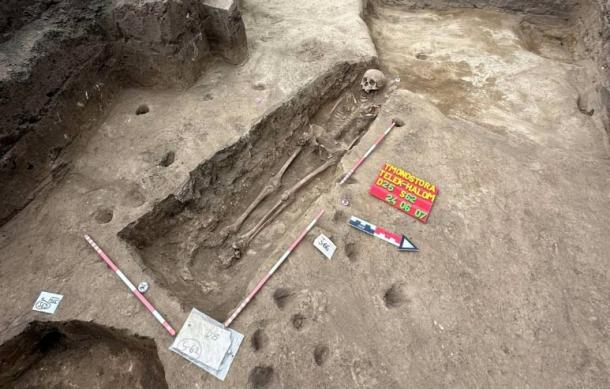The Bench Abbey Discovery
In an extraordinary archaeological undertaking, specialists have uncovered remarkable artifacts near Lake Tisza, Hungary. This year’s findings at a medieval abbey first discovered last year include a rare silver sacrificial set and a trove of Viennese pennies. The discoveries are part of a broader effort to map Hungary’s historical sites through micro-regional investigations.
During October 2023, in the settlement of Tomajmonostora, archaeologists from the National Archaeological Institute of the Hungarian National Museum’s Public Collections Center unearthed significant remains of a medieval abbey church known as the Bench Abbey. These findings are part of the “Archaeological Topographic Program,” a ten-year initiative aimed at identifying and documenting archaeological sites across Hungary. This program not only seeks to preserve historical and cultural heritage but also aims to lay the groundwork for future tourism development in the southeast area of Lake Tisza, explains an announcement on the Hungarian National Archaeological Institute’s Facebook page.

Dr. Gábor Virágos, Deputy Director General of Archaeology at the Hungarian National Museum, stated: “Last year, we cleared the layers of a three-ship abbey basilica and an early round church. We have found the monastery of the nation and the parish church belonging to the settlement before it.” This year, the discovery of a silver sacramental set, including a pottery wafer holder, has captivated the archaeological community. The set, dating back to the 13th or 14th century, was found in the hands of a deceased individual, suggesting it was part of a burial ritual.

Unearthing Medieval Wealth
Another significant find from the micro-regional research is a treasure trove of 70 silver coins, known as Viennese pennies (denars). These coins were uncovered in the Mezokeresztes area, a key location in Hungarian history due to the Battle of Mezokeresztes in 1596. The battle, a crucial conflict during the Fifteen Years’ War, saw a major clash between the Ottoman Empire and the Habsburg-led forces of the Holy Roman Empire.
The silver coins, dating back to the 13th and 14th centuries, were minted by Austrian princes and circulated widely in Hungary due to extensive trade relations. Enikő Kovács, a numismatist and research associate, explained, “Their presence is attested by treasures similar to the ones discovered just now, primarily from the western half of the country and from the trade road through Kassa to Krakow.”

Collaborative Archaeological Efforts
The exploration of the Battle of Mezokeresztes site involves extensive cooperation, with local communities playing a pivotal role. Volunteers from the community archaeology program, led by archaeologist Gábor Bakos, have been instrumental in the discovery and ongoing research. Bakos emphasized the importance of community involvement, stating: “The participation of local communities is key to preserving our cultural heritage. This collaboration is a good example that the results of micro-regional research are not only important for professionals but also add value to local communities, helping them connect with their town’s history and strengthening their identity.”

The current phase of the project involves field access and metal detection over a research area spanning more than 100 square kilometers (38.6 sq miles). This systematic approach marks the first comprehensive effort to uncover and document the site of Hungary’s largest battle during the Fifteen Years’ War.
Preserving the Past for the Future
The sensational finds from this year’s excavations are currently undergoing material examination and restoration at the archaeometry laboratory of the National Archaeological Institute. These efforts are crucial in preserving the artifacts and providing a deeper understanding of Hungary’s medieval past.
The discoveries near Lake Tisza not only shed light on historical events and cultural practices but also highlight the rich tapestry of Hungary’s heritage. As research continues, these findings promise to enrich our knowledge of medieval Europe and offer invaluable insights into the lives of those who lived centuries ago.

